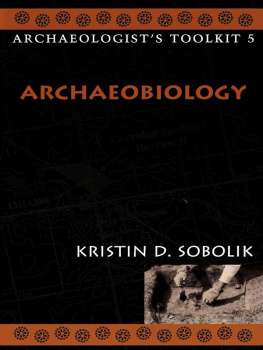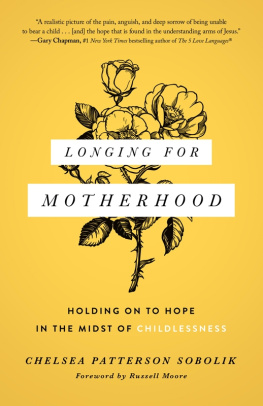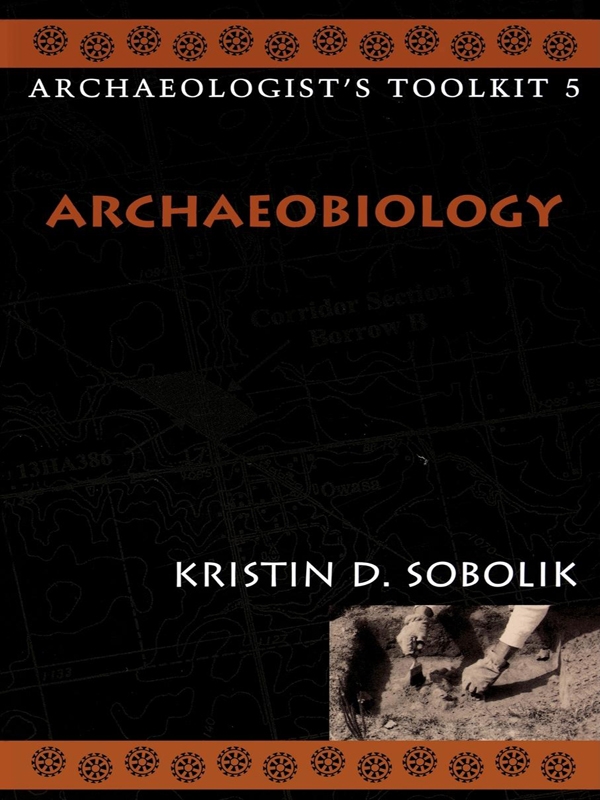I would like to thank Steve Bicknell, Rick Will, Tom Green, Larry Zimmerman, Kathryn Kamp, Tom Whittaker, Vaughn Bryant, Harry Shafer, Dinah Crader, David Sanger, Tom Alex, Larry Elrich, and Heather McInnis for their help in completing this book.
ABOUT THE AUTHOR AND SERIES EDITORS
Kristin D. Sobolik received her B.S. in biology from the University of Iowa (1986), M.A. in anthropology from Texas A&M University (1988), and Ph.D. (with a dissertation entitled Paleonutrition of the Lower Pecos Region) from Texas A&M (1991). She held a postdoctoral fellowship position at Southern Illinois University, where she edited Paleonutrition: The Diet and Health of Prehistoric Americans, and then joined the faculty at the University of Maine in the Anthropology Department and the Institute for Quaternary and Climate Studies, where she is an associate professor and director of the Zooarchaeology Laboratory.
Kristin has conducted archaeological work in the desertic regions of North America focusing in the Lower Pecos and Big Bend regions of Texas as well as throughout the southwestern United States. In addition, she has conducted research in Maine and at Mammoth Cave, Kentucky. Her recent research has centered on analyzing paleonutrition and possible prehistoric sex differences using DNA and hormonal content from paleofeces. She is also interested in the zoogeography of extinct and extant animal species, childrens health in the prehistoric Southwest, and evidence for prehistoric cannibalism. She lives with her husband, Scott, a writer and English instructor, and their four beautiful children ranging in age from 1 to 12.

Larry J. Zimmerman is the head of the Archaeology Department of the Minnesota Historical Society. He served as an adjunct professor of anthropology and visiting professor of American Indian and native studies at the University of Iowa from 1996 to 2002 and as chair of the American Indian and Native Studies Program from 1998 to 2001. He earned his Ph.D. in anthropology at the University of Kansas in 1976. Teaching at the University of South Dakota for twenty-two years, he left there in 1996 as Distinguished Regents Professor of Anthropology.
While in South Dakota, he developed a major CRM program and the University of South Dakota Archaeology Laboratory, where he is still a research associate. He was named the University of South Dakota Student Association Teacher of the Year in 1980, given the Burlington Northern Foundation Faculty Achievement Award for Outstanding Teaching in 1986, and granted the Burlington Northern Faculty Achievement Award for Research in 1990. He was selected by Sigma Xi, the Scientific Research Society, as a national lecturer from 1991 to 1993, and he served as executive secretary of the World Archaeological Congress from 1990 to 1994. He has published more than three hundred articles, CRM reports, and reviews and is the author, editor, or coeditor of fifteen books, including Native North America (with Brian Molyneaux, University of Oklahoma Press, 2000) and Indians and Anthropologists: Vine Deloria, Jr., and the Critique of Anthropology (with Tom Biolsi, University of Arizona Press, 1997). He has served as the editor of Plains Anthropologist and the World Archaeological Bulletin and as the associate editor of American Antiquity. He has done archaeology in the Great Plains of the United States and in Mexico, England, Venezuela, and Australia. He has also worked closely with a wide range of American Indian nations and groups.
William Green is the director of the Logan Museum of Anthropology and an adjunct professor of anthropology at Beloit College, Beloit, Wisconsin. He has been active in archaeology since 1970. Having grown up on the south side of Chicago, he attributes his interest in archaeology and anthropology to the allure of the exotic (i.e., rural) and a driving urge to learn the unwritten past, abetted by the opportunities available at the citys museums and universities. His first fieldwork was on the Mississippi River bluffs in western Illinois. Although he also worked in Israel and England, he returned to Illinois for several years of survey and excavation. His interests in settlement patterns, ceramics, and archaeobotany developed there. He received his masters degree from the University of Wisconsin at Madison and then served as Wisconsin SHPO staff archaeologist for eight years. After obtaining his Ph.D. from the University of Wisconsin at Madison in 1987, he served as state archaeologist of Iowa from 1988 to 2001, directing statewide research and service programs including burial site protection, geographic information, publications, contract services, public outreach, and curation. His main research interests focus on the development and spread of native agriculture. He has served as editor of the Midcontinental Journal of Archaeology and The Wisconsin Archeologist; has published articles in American Antiquity, Journal of Archaeological Research , and other journals; and has received grants and contracts from the National Science Foundation, National Park Service, Iowa Humanities Board, and many other agencies and organizations.
REFERENCES
| Appleyard, H. M., and A. B. Wildman |
| 1970 | Fibres of Archaeological Interest: Their Examination and Identification. In Science in Archaeology: A Survey of Progress and Research , D. Brothwell and E. Higgs (eds.), pp. 62433. Praeger, New York. |
| Asch Sidell, Nancy |
| 1999 | Prehistoric Plant Use in Maine: Paleoindian to Contact Period. In Current Northeast Paleoethnobotany , John Hart (ed). New York State Museum, Albany. |
| Barrows, David |
| 1900 | The Ethno-botany of the Coahuilla Indians of Southern California . Ph.D. dissertation, University of Chicago, Chicago. |
| Birks, H. J. B. |
| 1981 | Late Wisconsin Vegetational and Climatic History at Kylen Lake, Northeastern Minnesota. Quaternary Research 16:32255. |
| Bocek, Barbara |
| 1986 | Rodent Ecology and Burrowing Behavior: Predicted Effects on Archaeological Site Formation. American Antiquity 51(3):589603. |
| Bokonyi, S. |
| 1970 | A New Method for the Determination of the Minimum Number of Individuals in Animal Bone Material. American Journal of Archaeology 74:29192. |
| Bozell, John R. |
| 1991 | Fauna from the Hulme Site and Comments on Central Plains Tradition Subsistence Variability. Plains Anthropologist 36(136):22953. |
| Braidwood, L. S., and R. J. Braidwood (eds.) |
| 1982 | Prehistoric Village Archaeology in South-Eastern Turkey: The Eight Millennium B.C. Site at Cayn: Its Chipped and Ground Stone Industries and Faunal Remains. British Archaeological Reports International Series 138. Oxford University Press, Oxford. |
| Bryant, Vaughn M. Jr. |
| 1966 | Pollen Analysis of the Devils Mouth Site. In A Preliminary Study of the Paleoecology of the AMISTAD Reservoir. A Report of Research under the Auspices of the National Science Foundation (GS-667). National Science Foundation, Washington, D.C. |






